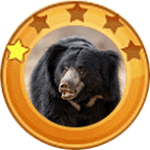- Home
- Shop
- Forest Series
- Grassland Series
- Desert Series
- Contact
- Home
- Shop
- Forest Series
- Grassland Series
- Desert Series
- Contact

Bear Series





2 DRIVING MODES WITH RC
Kids manual operation and parent remote control. The off-road SUV for one kid only can be moved forward and backward with the in-car control by the pedal and steering wheel, or be overridden by parents via the 2.4GHz RC with 3 speeds.
SAFE AND SMOOTH RIDE
Structured by toughened kid-friendly plastic, the twin-motor kids vehicle built with 4 spring-suspension knobby wheels allows the little driver fastened by the safety harness to conquer different terrains with ease.
RIDE ON GIFT FOR KIDS
This fully operational 12V ride on electric truck designed with appealing LED lights, accessible magnet doors, and a realistic Wrangler style is a perfect gift for your toddlers (3-6 years old) to begin an outdoor adventure.


CHARACTERISTICS
The Chipmunk is a member of the family Mammalia, Rodentia and Sciuridae. It is also known as the Striped Squirrel, the Timber Tiger and the Mini-bear. The body length among most Chipmunks ranges from 5.5 to 6.3 inches and the tail length is 5 Inches. Chipmunks typically weigh about 0.02 pounds and live about 5 to 10 years. They have small but prominent ears which face forwards, and small eyes on the sides of their heads. Most wild Chipmunks are lively.


Lorem ipsum dolor sit amet, consectetur adipiscing elit. Ut elit tellus, luctus nec ullamcorper mattis, pulvinar dapibus leo.


CHARACTERISTICS
The Sloth Bear, also known as the Honey Bear, is 5-6 feet long, covered with long, fluffy fur, light russet and dark to black. It has a special V-shaped white pattern on its chest, a slightly white muzzle and a black nose. The muzzle of the Sloth Bear is long, with a lip on top and no incisors in the lip to facilitate insect predation. The front feet are curved inward, allowing the Sloth Bear to crawl and dig. A male Sloth Bear weighs 170-300 pounds, while the female weighs 120-200 pounds.

RANGE AND HABITAT
The Sloth Bear is found mainly in India and Sri Lanka, with smaller numbers in Bangladesh, Nepal and Bhutan. It used to be found in the forests and grasslands of tropics, especially at low altitudes in drier woodlands and rocky areas. Once found everywhere in India and Sri Lanka, they are now a rarity.

DIET
Termites and ants are delicious food for the Sloth Bear. It will scrape at the structure with its large and powerful claws till it reaches and catches the fleeing termites, or disperse the soil with violent puffs to suck up through its long and tubular muzzle. The Sloth Bear also supplements its diets with honey, eggs, birds, flowers, stems, fruits, corn or carrion. The Sloth Bear is extremely fond of honey. It will climb to the top of the tree to knock down the beehive and then back to the ground to enjoy its sweet delicacy.

BEHAVIOR
The Sloth Bear is a kind of solitary animal which will rearing the bark of trees with its forepaws to mark its territories. It tends to be active at night, while the mother bear prefers to forage in the day for baby caring needs. The breeding season of Sloth Bears is usually between May and July, some areas may occur throughout the whole year. The baby bears are usually born in caves or in shelters under boulders, in litters of about 2, sometimes three. During the newborn period of about 3 months, the mother bear will stay in the den to wholeheartedly take care of its babies. When young cubs start walking and become sexually independent, they ride on their mother’s back to move. Sloth Bear does not hibernate because it lives in tropical areas. It does best at about 15.6-26.7℃ (60℉-80℉), easily discovered in dry forests. Large predators like tigers and leopards are the main natural enemies of the Sloth Bear, among which the male tigers have an overwhelming advantage over it.

The Chipmunk is a member of the family Mammalia, Rodentia and Sciuridae. It is also known as the Striped Squirrel, the Timber Tiger and the Mini-bear. The body length among most Chipmunks ranges from 5.5 to 6.3 inches and the tail length is 5 inches. Chipmunks typically weigh about 0.02 pounds and live about 5 to 10 years. They have small but prominent ears which face forwards, small eyes on the sides of their heads. Most wild Chipmunks are lively.
The Red Squirrel, a member of the Sciuridae, is an arboreal, omnivorous rodent often referred to as a Forest Seeder and folklore as the Devil King Squirrel.
The Arizona Gray Squirrel, also known as the American Gray Squirrel, is a member of the family Rodentia and Sciuridae. It is small in size, with gray fur and a belly between white and cream. It has long ears, no tufts of fur and a fluffy tail edged in white. The body is about 16-20 inches long and weighs up to 1.4 pounds.
The Rock Squirrel, also known as Sao Maozi or Stone Mouse, belongs to the rodent and is a species in the family Sciuridae. The most common natural predators of the Rock Squirrel include bobcats, owls, eagles and snakes. Though the Rock Squirrel is cute, alert, and courageous, it is still considered a pest due to its habit of destroying crops.
The Abert’s Squirrel is a member of the genus Sciurus with a body length of 18-22.8 inches, a tail length of 7.5-9.8 inches and a weight of 2.2 pounds, and can live up to 10 years in the wild. Its most distinctive feature is tassels of fur about 0.8-1.2 inches long at the tip of its ears, which looks very interesting. In addition, it is alert and agile.

Male Sloth Bear Arrives at the Smithsonian’s National Zoo
The Smithsonian’s National Zoo recently welcomed a new sloth bear into its zoological family. Niko, a 2-year-old male, arrived Oct. 6 from NaturZoo Rheine in Germany and joins 3-year-old female sloth bear Remi at the Zoo’s Asia Trail exhibit.
Per standard procedure, Niko is now in quarantine for approximately 30 days and is being cared for by keepers, nutritionists and veterinarians in an off-exhibit area. To keep Niko mentally and physically stimulated, keepers are providing him with a variety of enrichment, including tree trunks, branches, bobbin toys and puzzle feeders. When Niko makes his public debut in early November, virtual visitors will also be able to see the sloth bears up-close thanks to a new high-definition cam facing an outdoor cave. The sloth bear cave and webcam were made possible by donations to the Zoo’s 2015 Sloth Bear Appeal. In the meantime, Remi has access to both her indoor and outdoor habitats and Zoo visitors may be able to see Remi and chat with keepers during the daily 1:30 p.m. animal demonstration.
Niko’s arrival will add a boost to the Association of Zoos and Aquariums’ Species Survival Plan (SSP). The SSP scientists determine which animals to breed by considering their genetic makeup, nutritional and social needs, temperament and overall health. Currently, only 28 bears exist in the North American Population; all of them participate in the SSP. Because both Niko and Remi are quite young, it will likely be a few years before the bears breed and produce cubs. At this stage, keepers hope that the pair will be receptive to cohabitating and will spend time together as companions. Since Niko’s arrival, he and Remi have been able to see, smell and hear one another, and they appear to be very curious about and interested in one another. Once the quarantine period has lifted, keepers will begin formal introductions with and without mesh barriers between the bears.



Follow Us: